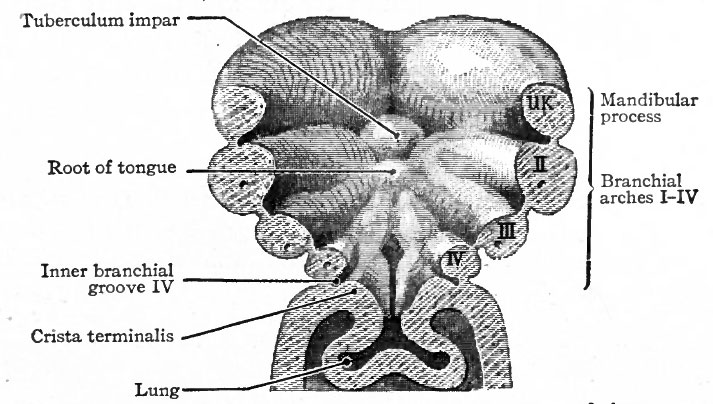File:Bailey249.jpg
Bailey249.jpg (713 × 404 pixels, file size: 71 KB, MIME type: image/jpeg)
Fig. 249. Floor of the pharyngeal region of a human embryo of about 3 weeks
Wilhelm His (1831-1904)
The tongue develops from three separate anlagen which unite secondarily.
In embryos of about 3 mm. a slight elevation appears on the floor of the pharynx in the region of the first branchial arch. This is the tuberculum impar, being, as the name indicates, unpaired, and is destined to give rise to the tip and body of the tongue (Fig. 249). Soon afterward two bilaterally symmetrical elevations appear on the floor of the pharynx, which are destined to give rise to the root of the tongue (Fig. 250). These paired elevations, arising in, the region of the second and third branchial arches, gradually enlarge and unite with each other and with the tuberculum impar, leaving between the latter and themselves, however, a V-shaped groove (Fig. 251). At the apex of the groove there is a depression the foramen cecum lingua which is the external opening of the thyreoglossal duct (see p. 301). The groove later disappears, but its position is indicated in the adult by the vallate papillae.
- Text-Book of Embryology: Germ cells | Maturation | Fertilization | Amphioxus | Frog | Chick | Mammalian | External body form | Connective tissues and skeletal | Vascular | Muscular | Alimentary tube and organs | Respiratory | Coelom, Diaphragm and Mesenteries | Urogenital | Integumentary | Nervous System | Special Sense | Foetal Membranes | Teratogenesis | Gallery of All Figures
| Historic Disclaimer - information about historic embryology pages |
|---|
| Pages where the terms "Historic" (textbooks, papers, people, recommendations) appear on this site, and sections within pages where this disclaimer appears, indicate that the content and scientific understanding are specific to the time of publication. This means that while some scientific descriptions are still accurate, the terminology and interpretation of the developmental mechanisms reflect the understanding at the time of original publication and those of the preceding periods, these terms, interpretations and recommendations may not reflect our current scientific understanding. (More? Embryology History | Historic Embryology Papers) |
Reference
Bailey FR. and Miller AM. Text-Book of Embryology (1921) New York: William Wood and Co.
Cite this page: Hill, M.A. (2024, April 19) Embryology Bailey249.jpg. Retrieved from https://embryology.med.unsw.edu.au/embryology/index.php/File:Bailey249.jpg
- © Dr Mark Hill 2024, UNSW Embryology ISBN: 978 0 7334 2609 4 - UNSW CRICOS Provider Code No. 00098G
File history
Click on a date/time to view the file as it appeared at that time.
| Date/Time | Thumbnail | Dimensions | User | Comment | |
|---|---|---|---|---|---|
| current | 10:33, 21 January 2011 |  | 713 × 404 (71 KB) | S8600021 (talk | contribs) | {{Template:Bailey 1921 Figures}} Category:Human Category:Cardiovascular |
You cannot overwrite this file.
File usage
The following 3 pages use this file:

